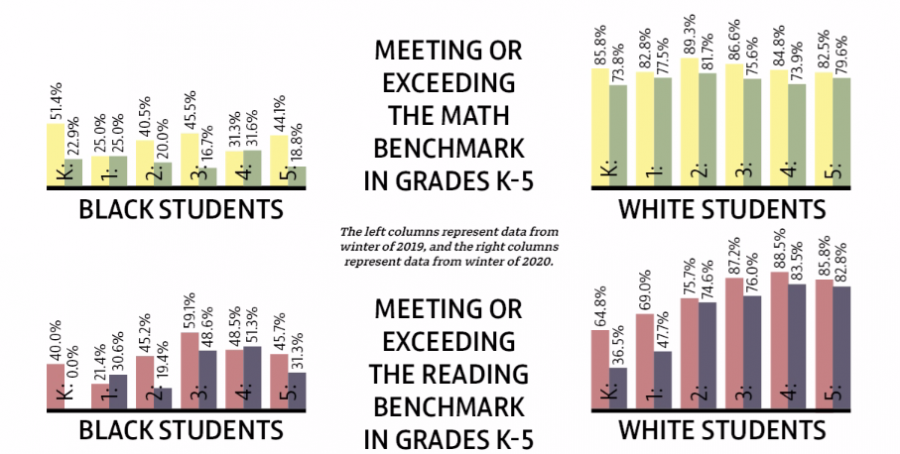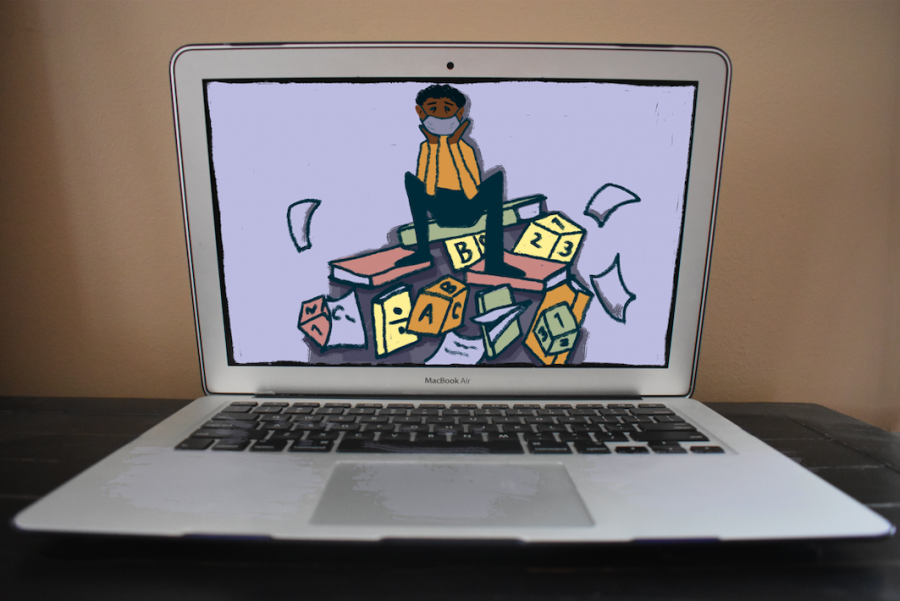When looking at the scores from K-8 benchmark assessments, many educators across the district were concerned with decreases in achievement this year. Art by Graesen Joyce.
The COVID-19 gap
Zero percent (0/35). This is the percentage of Black kindergarteners in the Kirkwood School District (KSD) who met the reading benchmark in winter 2020. On the other hand, 36.5% of white kindergarteners met or exceeded the reading benchmark.
This large gap was not just a trend in kindergarten literacy scores — but also seen in grades 1-8. Take for example the third grade math benchmark scores: 16.7% of Black students met or exceeded, while 75.6% of white students met or exceeded. This gap appeared again in the second grade reading scores: 19.4% of Black students and 74.6% of white students. When looking at this benchmark data, it’s clear that COVID-19 has drastically affected these scores, with a trend noted of lower percentages in winter 2020 when compared to other years. Zero percent of Black kindergarteners met the reading benchmark, while in 2019, this same group reached 40%. In fifth grade, 18.8% of Black students met or exceeded the math benchmark, but just one year prior, that percentage was at 44.1%. The scores of many other grades dropped this year as well.
This December, KSD students from kindergarten to eighth grade took the annual math and reading benchmark tests: Early Math Composite and Early Reading Composite (K-1) and aMath and aReading (2nd-8th). When looking at the scores from these assessments, many educators across the district were concerned with decreases in achievement this year, with Assistant Superintendent of Curriculum & Instruction Dr. Bryan Painter, being one of them.
“[The racial gap] is concerning. Unfortunately, it’s not new. It’s been something that has been there and something that we have a responsibility to continue addressing,” Painter said. “So as we continue these conversations, as we continue looking at the data [and] as we continue to analyze how we teach and how we support all of our kids, the most important thing is that we continue the conversation. We have to do the work and we have a responsibility to do better for all our kids.”
According to North Glendale Elementary School Principal Jennifer Sisul, the discrepancies between white and Black students in the data is heartbreaking to her. Sisul has also recognized a gap prior to viewing this year’s data.
“But with this [benchmark data], it is glaring and it’s in your face, unfortunately. That little bar of 35 [Black kindergarteners who took the benchmarks] is a gigantic bar to us. It just feels like this time with COVID, we’re all at such a heightened awareness anyway and we’re so worried about everything, so it’s been all around just a super tense time. ”
This observation was also shared by Nelson Taylor, Nipher Middle School guidance counselor, who has worked in the district for 10 years. Each year, Taylor views the benchmark scores and said he notices the disparity between Black and white students. He also highlighted the amount of Black students learning virtually. As of right now, students who identify as a person of color (non-white) make up of about 23% of all students who are learning in-person in K-5 schools. At the KSD At-Home program, those who identify as students of color make up roughly 38% who are learning online from K-5.
“This year is even more concerning [due to COVID-19], and it is unfortunately having more of an effect on people of color. As a result, many of our African-American students and families have decided to stay home,” Taylor said. “[This] removes them from buildings and instructions that are in place for them to get that in-depth, one-on-one instruction that we may need to help continue to increase scores.”
Denise Griffin, Tillman Elementary fourth-grade teacher, said all kids have experienced major setbacks due to COVID-19. However, she believes students of color are suffering the most.
“I think a lot of those [setbacks] are attributed to just mental health and access to resources and support,” Griffin said. “I know for a fact Kirkwood has done a lot of professional development about how we can support our students of color, and right now the best thing for all kids is making sure they know they’re safe [and] they know they’re supported. The academics will come [next].”
In response to the winter benchmark assessments, every KSD school has its own data team that has been analyzing statistics in order to try different solutions. According to Sisul, the schools will look for student respondance to interventions in March to ensure they are on the right path, and another formal benchmark will be administered in May to compare with the December benchmark. In addition, she said schools are working on a comprehensive summer school plan that would keep kids reading in those off months. Painter also elaborated on the current steps being taken, concentrating on Tier 1; classroom instruction for all students.
 “We think about the interventions, but we have to do something with what [all students are] getting. And that’s what we’re addressing, we call it Tier 1,” Painter said. “That’s what we’re focusing on, our Tier 1, and then at the schools we have reading interventionists and specialists who are really thinking about their kids that are in Tiers 2 and 3 that need that extra support and how we can do even more with them. But frankly, with our data, the way it is, it’s Tier 1 that we have to focus on.”
“We think about the interventions, but we have to do something with what [all students are] getting. And that’s what we’re addressing, we call it Tier 1,” Painter said. “That’s what we’re focusing on, our Tier 1, and then at the schools we have reading interventionists and specialists who are really thinking about their kids that are in Tiers 2 and 3 that need that extra support and how we can do even more with them. But frankly, with our data, the way it is, it’s Tier 1 that we have to focus on.”
There are currently conversations between principals and teachers about more significant changes to support early reading, aiming to increase benchmark scores. There is a specific focus on phonics, which is a way to teach kids how to read and write by involving the relationship between sounds and their spellings. Sisul said schools are figuring out the best resource to use for phonics, and how to teach that as best they can.
“Right now, we use lots of different [resources], but we really need to just get down to what is the best program or resource out there,” Sisul said. “Then we’ll all get on board and use that resource.”
While Tier 1, summer school and phonics are all steps being focused on to increase benchmark scores, Griffin also believes that by supporting kids with their mental health, the academics will eventually follow. She believes if teachers fail to do this, kids falling behind is a likely future.
“Like we say at Tillman, we’re building the plane as we’re flying it. We need to give each other grace, and give each other support,” Griffin said. “I think [success] starts inside and knowing that [the students] are in a safe place, knowing that they can make mistakes and building them up so that they can look back at this COVID time and say, ‘Wow, I had great teachers supporting me and I have a great community’— that’s what we want.”

